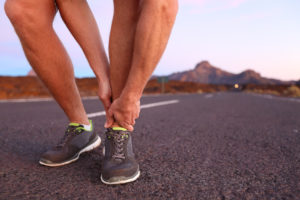Causes of Foot Pain All Runners Need to Know
Many runners have a love/hate relationship with their feet. They are a runner’s most important tool, but they also suffer a lot of pain from all the hard work. All types of runners from casual joggers to marathon champions are susceptible to several types of foot injuries and foot pain. These issues can stem from a variety of things, from over-exertion to improper footwear.
Four common foot conditions highlighted in this post include:
- Plantar fasciitis
- Shin splints
- Stress fractures
- Metatarsalgia
If you are concerned that you might have sustained one of the foot injuries discussed, we recommend trying some at-home treatments listed below. However, if the pain does not improve or even worsens, schedule an appointment with an OSMS physician right away.
- Plantar Fasciitis
Plantar fasciitis is a very common foot injury that causes pain on the bottom of the heel. It occurs when the band of tissue supporting the arch of your foot becomes inflamed or irritated. Plantar fasciitis is typically caused by too much pressure on the heel or tissue tears.

Symptoms of plantar fasciitis include:
- A deep stabbing feeling in the arch of your foot
- Difficulty walking right away in the morning
- Your foot tightening up after sitting for a long period of time
How to manage plantar fasciitis:
- Decrease or even stop any activity that irritates the painful area
- Apply ice for 20 minutes a few times per day
- Take over-the-counter ibuprofen, as dosed, especially early on with symptoms
- Stretch your calves and foot
- Shin Splints
Shin splints is a term that describes pain along your inner leg. Muscles, tendons and bone tissue around the tibia become inflamed, which causes pain along the inner edge of the tibia. They typically occur after any type of physical activity, but runners are at a high risk due to the excessive impact on their feet and lower legs.
Symptoms of shin splints include:
- Sharp pain along the inner, lower leg
- Occurs during and after exercise
- Is painful to the touch
How to treat shin splints:
- Follow the RICE method: rest, ice, compression and elevation.
- Take over-the-counter medication such as ibuprofen or aspirin to help with swelling and pain.
- Wear shoes with good support so you do not further irritate the affected area.
- Stress Fractures
A stress fracture occurs when the bones and muscles in your foot are overused. Too much activity, or a sudden change in activity, causes stress transferred to the bone, resulting in a small crack. Foot stress fractures are often caused by increasing the amount or intensity of running too quickly.
Symptoms of a stress fracture include:
- Pain in the forefoot
- Pain worsens throughout the day, especially with normal walking
- Pain while running
- Inability to complete a run
How to treat a stress fracture:
- Rest for six-to-eight weeks so the stress fracture can heal. It seems like a long time, but if you keep running or resume running too early, the stress fracture can develop into a larger problem.
- Shoe inserts or braces may be used to aid healing.
- Immobilization in a boot may be necessary
- Visit an OSMS physician to ensure your fracture will heal well.
- Metatarsalgia

Simply put, metatarsalgia is pain in the ball of your foot. When a head or many heads of the foot bones become irritated, metatarsalgia occurs. There are many causes, including soft tissue problems as well. It could also be caused by running with improper footwear, which may lead to improper or excessive contact with the ground. The bone then begins to break down and become painful.
Symptoms of metatarsalgia include:
- Pain in the ball of your foot, which may be burning or aching
- Numbness or tingling in your toes
- Not being able to walk after a run
How to treat metatarsalgia
- Wear comfortable, supportive shoes.
- Rest the affected foot.
- Avoid walking barefoot.
If you are struggling with foot pain, Schedule an Appointment here.








